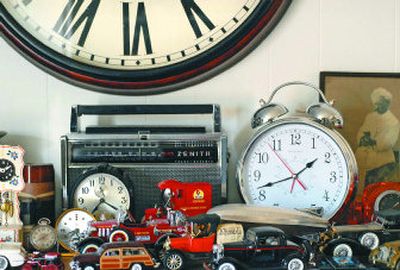Fine-tuning hands of time

Nat Williams loves the passing of time.
The ticks and tocks. The springs and gears and hammers. The chimes, dings and whirs.
Clocks represent the perfect mix of art, technology and function, Williams says. “And they are always beautiful.”
Williams, a retired acoustics consultant, runs a small, clock-repair business out of his North Spokane home. He calls the business Old Technology Repair, because, he says, “clocks were our very first high-end technology.”
Williams is a living encyclopedia on many topics, especially clocks. He patiently explains the rules of energy and how the number of gears corresponds to how long the clock runs between windings. He talks about Archimedes, the Greek inventor and mathematician credited with building a water clock in 300 B.C.
“There’s always been the desire to keep time,” he says.
He can estimate the year a clock was made by looking at its inner workings or the way the hands connect to the face.
“You can date a car by its technology,” Williams says. “It’s the same thing with clocks.”
About 10 years ago, Mitch Silver, owner of Silver Auctions, bought the estate of a clock collector. Silver says he kept the collection boxed up because he didn’t know its value. Then he met Williams.
“His expertise has given me a great deal of comfort,” says Silver, who plans to sell the collection with Williams’ help during a tag sale this weekend (see “Get out of the house,” Page 4). “He knows the rarity, the desirability and the history of things.
“It’s a real treat to work with him.”
Williams’ passion for technology began with clocks.
At 14, he bought a shelf clock for 50 cents at a second-hand shop in Santa Monica, Calif. He squirted oil into the gears to get it working again – something he’d never do so blithely today, he notes – and gave it to his mom as a present. “She used it for many years,” he says, adding that he inherited the clock when she died. He recently took it apart for a cleaning.
As a young man, his focus turned from fixing clocks to mastering sound. He spent more than 30 years as an audio designer and acoustics consultant in Los Angeles, Las Vegas, Eugene, Ore., and Seattle. He still acts as a sound consultant on a “friendly basis.”
“It’s more of a hobby now,” he says.
Shortly after moving to Spokane in 1999 with his wife, Margie, Williams’ interest in clocks renewed and he began buying collections of mechanisms. Friends and family members began bringing him broken clocks.
He loves getting a clock “in good going order,” so he usually only charges for parts. Sometimes he trades his work for a customer’s, such as the time a lady cleaned his house after he repaired her beloved clock.
Williams’ reputation as a fix-it man is growing. While working on the early 1900s sidewalk clock at 905 W. Riverside Ave., the maintenance supervisor for The Spokesman-Review building asked Williams if he’d come look at a clock in the newspaper’s Marketing Department. The hands hadn’t moved in years. When Williams looked inside the wall clock – made in about 1910, Williams estimates – he noticed the movement was missing.
About two years earlier, Williams had bought a collection of clock parts from a man who’d bought the assortment from another collector. Among the gears and hammers, Williams found the missing movement, fixed it and returned it to the clock
Williams guesses the collection’s first owner tried to fix the newspaper’s clock but couldn’t get the movement working.
“I have two gifts,” Williams says. “A general understanding of things and enough smarts to know who knows more than I do.”
Williams knows clocks.
More than 20 clocks decorate his living and dining rooms. They rest on shelves and mantels, hang on hooks and sit on the floor. In his office, he keeps his treasured “Regulator” - the same model of clock that ticked and tocked its way through the 1950’s Western “High Noon.”
“It’s very accurate,” Williams says.
In his downstairs workshop, there is a jumble of clock parts and pieces. He picks up a French hotel clock that ran only after a guest slipped a franc through a slot like a juke box. Two francs inside the clock date to 1924. He points to a clock fashioned in the art nouveau style of the late 1800s, another in the art deco style of the early 1900s.
Every room in his house has several clocks, he says.
His wife has only one rule: Nothing that chimes or tocks can live on the second floor, where the couple sleeps.
“They are all battery or quartz up there,” he says.
This weekend, Williams and other clock enthusiasts will gather at the Spokane Convention Center for the regional convention of the National Association of Watch and Clock Collectors. Members buy, sell and trade parts.
The convention is for members only. While many set up booths “like a big garage sale,” Williams says he’s going there to trade clock stories and find unusual odds and ends.
“The way I’ve done life,” Williams says, “it has been nothing but fun for me.”